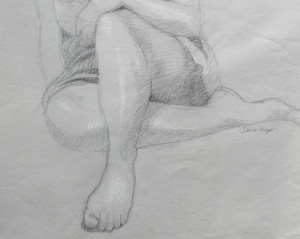I had to make a tough choice. Do I want to primarily focus on continuing to develop abstract work? Or will I go back to my roots and paint figures and portraits? One of my favorite instructors while attending York Academy of Arts was Ted Fitzkee. He taught his students how to finesse the oil painting materials and techniques of the old masters. We mixed our own oil paints from powdered pigments. It was a very “old school” art education. Pure. No computers, no digital methods—just traditional tools and techniques. After we were taught basic drawing and composition skills, we moved up to anatomy as a foundation for drawing classical figures and portraits. It was thoroughly fun, and such a challenge. But it was a challenge in the best sense of the word, provoking us to practice more and work harder.
Even though I’m focused on painting abstract art at this stage of my journey, I still have a major pull toward drawing portraits and figures. When I watch some of the painters on YouTube demonstrating figure painting, it takes me back to my younger days at York Academy of Arts where I learned to draw the figure. Most artists will tell you that the human figure is the most challenging subject to draw or paint. Animals are easy by comparison. To draw or paint the figure well, takes practice, study, and great observation skills. You also must have excellent command over your medium—oil paint, pastel, etc. Because it’s not easy, it can be a lifelong pursuit.
On the other hand, so many people have zero appreciation for the challenge of creating abstract art. Many think painting abstract art must be easy because you don’t really need to be good at drawing. They think you just scribble some color down and call it good. It’s too simple—they think—to really be called art. And I’ll admit, I used to think that way… a long time ago.
The truth is, it’s easy to do a lousy abstract painting, but it’s hard to do a wonderful abstract painting. Color must be chosen carefully. If you have no knowledge of color theory, you can muddy your colors in a heartbeat. Without studying color theory, it can take a lot of trial and error to work well with color. I’ve seen countless abstract paintings where brown was the unintended result of two colors swirled together with a brush on a canvas. On the opposite side of the spectrum are paintings where all the color is straight from the tube. In my opinion, the artist is missing the sophisticated, subtle variations that can be achieved through smart color mixing.
Here’s one difficulty that came up for me. Since I did know how to draw and had studied classically, I had to learn to loosen up in order to paint freely without a model, subject, or reference material in front of me. Well, I sometimes use reference material but it’s usually just a general idea of a black, gray, and white composition. If you’re an artist used to painting detail it’s awkward at first to free yourself from the picky details, but very fun when your spirit just takes over.
When I first began experimenting with abstracts in acrylics. I figured, fast drying equals instant gratification. I was both right and wrong about that. There’s something very special about oil paint. I didn’t realize how special… until I started to paint with acrylics. They both have their place. My comfort zone was oils, so I had to battle with and learn to appreciate the quick-drying properties of acrylics. Keeping the paint from drying too fast in the Arizona desert air was, at first, pushing me toward insanity. Thank God I found a system.
The traditional elements of art and design still apply in abstract art; they are not abandoned. Focal points can still be created by using contrasting value, juxtaposition of color, line, hard edges, etc. An art education helps me more easily understand how to put all the elements together, but in the end, it’s the hours of practice with the materials that bring any artist to a higher level of mastery.
Although I’m creating abstract art at this stage of my career, hopefully I will get to sneak in some classical drawings and figurative work once in a while for the pure fun of it. We’ll see how it all shakes out. There’s reward in the diligent pursuit of each.
I’d love to hear your comments, thoughts or questions.





I love abstracts and have been selling some in the last year in my showroom but personally- I love the human figure. Because I have a totally untrained eye- I see the detail and so appreciate God’s creation. Please do not forsake this subject matter. It is dear to God’s heart too.
Leslie. Thanks for that word of encouragement. I agree with you! I was just thinking about how I could incorporate figures — perhaps with an abstract background. I’ve seen other artist successfully use both together.
Thank you for mentioning my dad Ted Fitzkee. He loved his students and loved teaching. It was special for me to see you honor him here.
Thanks for your comment, Kate. I’ve spoken to many of the York Academy students on Facebook who remember your dad fondly. He was an excellent teacher and artist; he was engaging and always had a good sense of humor. I often wish some of his art would be posted online somewhere.